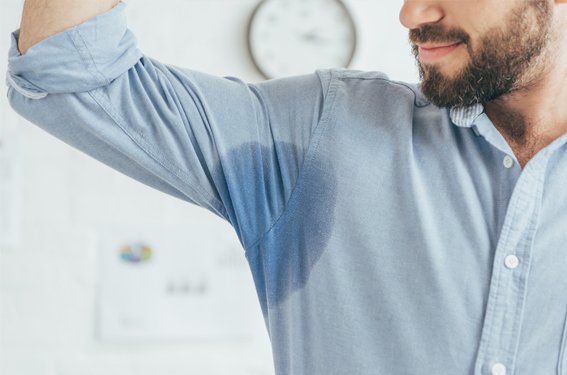Excessive Sweating or Hyperhidrosis
Excessive sweating, also known as hyperhidrosis is a condition that can be severe enough to disrupt a person’s life. This can have an impact on the ability to exercise and can affect relationships and emotional wellbeing.
This type of excessive sweating particularly involves the armpits but can occur on any part of the body. It is due to overactivity of the sweat glands and is not necessarily related to the temperature or your clothing or level of exertion. It becomes a problem when the sweat is visible especially under the arms, where wet patches can be seen on clothing.
How do you treat excessive sweating & hyperhidrosis?
There are a few treatments available for excessive sweating and you may have tried some of these, as a few can be found over-the-counter without a script. There are topical preparations such as roll-ons and sprays and these are called antiperspirants and available at chemists or at supermarkets. The most potent topical therapy contains aluminium chloride 20% and this is also known as Driclor. Another option is called iontophoresis. This helps to decrease sweating in the treated areas. It is used mainly on the hands and feet and rarely can be configured to use in the axilla. Iontophoresis involves using a very small electric current equivalent to a battery to stop the production of sweat. The machines need to be hired or bought and they are used initially every day and then can be used on a weekly basis. Some people cannot use these such as pregnant woman and people with a pacemaker.
TREATMENT FOR AXILLARY HYPERHYDROSIS
Treatment is very effective and is now covered under the PBS in Australia for axillary hyperhidrosis. It is very effective with noticeable effects starting after 2 days and a full effect within a week. The treatment lasts around 7-9 months.
ORAL MEDICATION
There are some tablets that can be taken to decrease sweating. However, in practice, the side-effects of these often outweigh the benefits.
Self care tips
Excessive sweating can have an immense impact on a person’s life. If standard over-the-counter products do not control sweating, then it is best to see a dermatologist or other health care professional to assess the nature of the excessive sweating and exclude other causes such as certain medical conditions that can lead to excessive sweating. If these have been excluded then there are options to help with this.
There are some useful tips that can be seen in the American Academy of Dermatology website (https://www.aad.org). Remember, if you are affected by sweating, causing you embarrassment in the workplace, public and meeting people, then we can help.
Book in for an Initial Consultation with one of our Dermatologists below.
If treatment is necessary, our team will help to book in your treatment after your initial consult if appropriate.
All medical and cosmetic procedures involve some risks. The information provided here is for general educational purposes only. The results achieved for patients in before and after pictures are individual and may not be achievable for you specifically. For specific advice regarding your situation, please book an appointment at NSDL.









